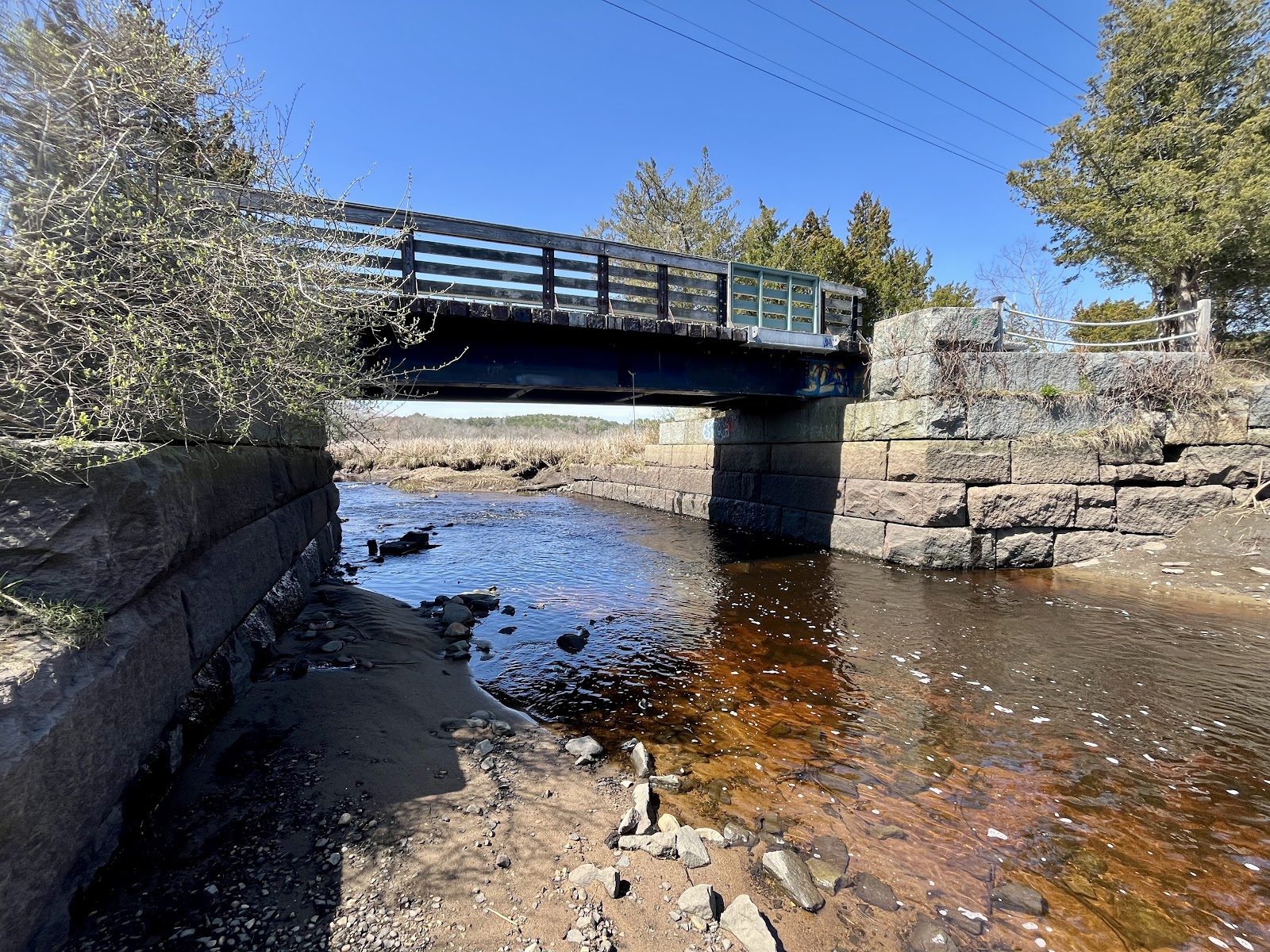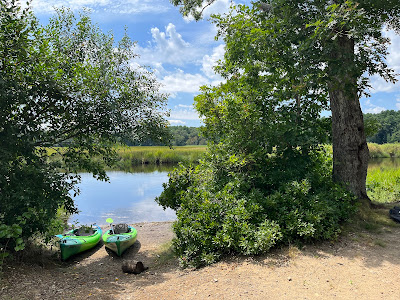There was no fanfare, no press conference, and certainly no “last spike” celebration, but in mid-June, when construction completed on a 500-foot boardwalk in a remote corner of Red Gold Farm, I couldn’t have been the only one doing a Happy Dance. Why? Because the boardwalk was the final piece of infrastructure required to create a public pathway (almost) all the way across the town of Marshfield!
Along with Rockland’s 3-mile Rail Trail and Norwell’s 3.5-mile Pathway, this makes Marshfield the third South Shore community with a public trail that spans the town. In Marshfield, it’s all part of the Bridle Path and Rail Trail, a route established in the 1870’s by what was soon to become the Old Colony Railroad. Keep reading to learn how to access it.
Please note that altogether, this route extends for at least six miles, across four different watersheds! If you do it all at once, out and back, it’s a 12-mile journey. Alternatively, you could explore it in pieces, or stage a second vehicle at the other end. The route described below goes from south to north.
Hoyt-Hall Preserve
Our walk across Marshfield begins at the Hoyt-Hall Preserve, a diverse 123-acre property in the Duxbury Back River watershed, owned by the Wildlands Trust. Look for the parking area at 780 Careswell Street. Follow the trail to Long Tom Pond, and then turn left. After tracing two sides of the pond, you’ll enter a pine forest. Very soon, you’ll see an unmarked but well-established trail to the left. Follow it, and after 0.15 miles you’ll reach the southernmost section of Marshfield’s Rail Trail, which connects Careswell Street to Stagecoach Drive. Turn right, and follow the old railroad bed all the way to the end, where you’ll find a large metal gate.
Black Mount Detour
You’ll be stepping off the trail for a very short distance here, circumventing a culvert that helps channel stormwater out of the Black Mount neighborhood. Turn left at the metal gate and walk less than a tenth of a mile up Stagecoach Drive. Look to the left, in the woods, to see where the railroad bed continues. (Hint: It’s before the next house.) After another tenth of a mile, you’ll arrive at the boardwalk. Note: Happy Dance!
Red Gold Farm
This 500-foot boardwalk is the perfect place to note that not only have you entered a new property, Red Gold Farm, you’ve entered a different watershed. The wetlands that surround you are tributaries to the Green Harbor River. Fifty years ago, the railroad bed was still passable on foot here, but water levels are higher now. The boardwalk provides a much-welcome alternative.
When you reach the end of the boardwalk, turn left. You may be tempted to continue straight along the old railroad bed, but this is not recommended, as some sections are impassable. Instead, continue along the pond until you arrive at the first of several cranberry bogs. Then turn right to follow the main trail through this recently-acquired conservation property. Note: While the main trail is the quickest, consider exploring some of the side trails, around the cranberry bogs, for additional views of the river.
Toward the end of the main trail, you’ll see another metal gate, but if you continue a little farther, you’ll find a wooden footbridge to the right. Cross the bridge and you’ll be back on the old railroad bed. Turn left, and soon you’ll arrive at the Green Harbor River. Stop on the bridge to admire the view, then continue to Webster Street.
Webster Street Detour
In the summer of 2024, Marshfield residents were thrilled to see a sidewalk installed along one side of busy Webster Street, ... but also perhaps a bit puzzled, as the sidewalk came to an end, rather abruptly, at a seemingly random spot. The sidewalk is actually part of the Rail Trail, providing a detour for an area sold to private owners after the railroad ceased operations. Follow the sidewalk north, all the way to the town center. A crosswalk provides access to Dandelion Park, and the first of several informational kiosks for the Bridle Path and Rail Trail.
Dandelion Park
The route becomes easier to follow now. From here, it’s a straight shot to Station Street, with much to admire along the way. Stop first at the kiosk, which features a map and some fascinating local history. Take a quick meander through Dandelion Park and then continue up the trail. You’ve now entered your third watershed: the South River. Follow the trail another 0.15 miles and admire the view.
Francis Keville Footbridge
Behind the scenes, for the last 25 years and more, the Town of Marshfield has been slowly and deliberately building its Bridle Path and Rail Trail. A key step was the 2001 installation of the Francis Keville Footbridge. Not only does the bridge connect the northern and southern parts of town, it offers some gorgeous views of the South River. And access too! The town provides a seasonal gangway and float here – an ideal spot to launch a canoe, kayak or SUP. Beyond the bridge, you could take a short side trip into Pratt Farm, a 34-acre conservation parcel with a half-mile out-and-back trail. Or continue north on the Rail Trail, crossing South River Street to the start of the Bridle Path (and another kiosk).
The Bridle Path
You are now about halfway through your journey. While the trail itself doesn’t look much different, it has a new name. The Bridle Path exists because years ago, Marshfield decided the railroad bed would remain open, in perpetuity, for equestrian access. Lead your horse by its bridle, or just continue walking for 2.5 miles ... all the way to Pinehurst Road. Along the way, you’ll cross Clay Pit Road and Ferry Street (with a couple more kiosks).
Note: If you have time for a major detour, you might also explore the adjacent 775-acre Carolina Hill Reservation, which borders the Bridle Path north of Ferry Street. If you’re blessed with boundless energy, you could do a long loop through both the Carolina Hill and Furnace Brook Watershedconservation areas!
Station Street and Beyond
When you reach the end of the Bridle Path, at Pinehurst Road, take a moment to contemplate your location, as now you are truly on the other side of town! The Rail Trail continues a little farther north, to Station Street, not far from where the bustling Seaview train station once stood. You’ve traveled at least six miles now, and perhaps have seen Marshfield from a refreshingly different perspective.
But are you all the way across town? Not quite. Again, because land was sold to private owners in the 20th century, the next section of the railroad bed is not accessible to the general public. You could walk a mile up Summer Street, but in the absence of sidewalks, I don’t recommend it. (Note: Let’s get this on the Town of Marshfield’s radar, for future Public Access projects!)
Damon’s Point
The final leg of the journey begins at the southern end of Damon’s Point Road, off Summer Street, at the intersection with Macombers Way. We’re in yet another watershed now – the North River. Murdock’s Pond, to your left, marks the spot where Hannah Eames Brook becomes Macombers Creek. From 1871-1839, the Marshfield Hills Railroad Station stood here. Today’s Damon’s Point Road extends over the railroad bed. It’s a pleasant street to walk along, and at the end, there’s a magnificent prize!
Damon’s Point, on the banks of the beautiful North River, is the final stop. A 1939 hurricane destroyed the railroad bridge, but the town built a lovely observation deck and seating area on its footings, along with seasonal ramps, docks and floats for boaters. And the view? It’s among the best around, as you can look out for quite a distance, in both directions, across the estuary. Note: One more Happy Dance... you’ve completed your journey! Now go home and soak your feet.
If you enjoy the outdoors, be sure to check out our Explore South Shore program for 2025. Every morning, we highlight one of the region’s best nature places on Facebook and Instagram. Every Saturday, we feature a long walk. Not on social media? We’ve listed all the locations on our website as well!
by Kezia Bacon
July 2025
Kezia Bacon's articles appear courtesy of the North and South Rivers Watershed Association, a local non-profit organization devoted to protecting our waters. For membership information and a copy of their latest newsletter, contact NSRWA at (781) 659-8168 or visit www.nsrwa.org. You will also find 27+ years of Kezia’s Nature columns there. For more information about the “Where in the Watershed?”/Postcards from the ‘Shed Contest, visit https://www.nsrwa.org/2025-nsrwa-explore-south-shore-contest-rules/























